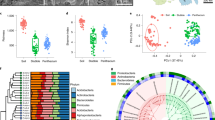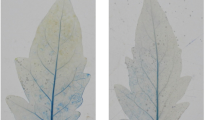Abstract
Antifungal proteins (AFPs) of fungal origin have been described in filamentous fungi. AFPs are small, highly stable, cationic cysteine-rich proteins (CRPs) that are usually secreted in high amounts and show potent antifungal activity against non-self fungi. The role of AFPs in the biology of the producer fungus remains unclear. AFPs have been proposed as promising lead compounds for the development of new antifungals. The analyses of available antifungal CRP sequences from fungal origin and their phylogenetic reconstruction led us to propose a new classification of AFPs in three distinct classes: A, B and C. We initiate for the first time the characterization of an AFP in a fungal pathogen, by analysing the functional role of the unique afpB gene in the citrus fruit pathogen Penicillium digitatum. Null ΔafpB mutants revealed that this gene is dispensable for vegetative growth and fruit infection. However, strains that artificially express afpB in a constitutive way (afpB C) showed a phenotype of restricted growth, distortion of hyphal morphology and strong reduction in virulence to citrus fruits. These characteristics support an antifungal role for AfpB. Surprisingly, we did not detect the AfpB protein in any of the P. digitatum strains and growth conditions that were analysed in this study, regardless of high gene expression. The afpB C phenotype is not stable and occasionally reverts to a wild type-like phenotype but molecular changes were not detected with this reversion. The reduced virulence of afpB C strains correlated with localized fruit necrosis and altered timing of expression of fruit defence genes.







Similar content being viewed by others
References
Acosta R, Rodríguez-Martín A, Martín A, Nuñez F, Asensio MA (2009) Selection of antifungal protein-producing molds from dry-cured meat products. Int J Food Microbiol 135:39–46
Alós E, Distefano G, Rodrigo MJ, Gentile A, Zacarías L (2014) Altered sensitivity to ethylene in ‘tardivo’, a late-ripening mutant of clementine mandarin. Physiol Plant 151:507–521
Ballester AR, Lafuente MT, Forment J, Gadea J, De Vos RCH, Bovy AG, González-Candelas L (2011) Transcriptomic profiling of citrus fruit peel tissues reveals fundamental effects of phenylpropanoids and ethylene on induced resistance. Mol Plant Pathol 12:879–897
Ballester AR, Lafuente MT, De Vos RCH, Bovy AG, González-Candelas L (2013a) Citrus phenylpropanoids and defence against pathogens. Part I: metabolic profiling in elicited fruits. Food Chem 136:178–185
Ballester AR, Teresa Lafuente M, González-Candelas L (2013b) Citrus phenylpropanoids and defence against pathogens. Part II: gene expression and metabolite accumulation in the response of fruits to Penicillium digitatum infection. Food Chem 136:285–291
Batta G, Barna T, Gáspári Z, Sándor S, Kövér KE, Binder U, Sarg B, Kaiserer L, Chhillar AK, Eigentler A, Leiter E, Hegedüs N, Pócsi I, Lindner H, Marx F (2009) Functional aspects of the solution structure and dynamics of PAF - a highly-stable antifungal protein from Penicillium chrysogenum. FEBS J 276:2875–2890
Brogden KA (2005) Antimicrobial peptides: pore formers or metabolic inhibitors in bacteria? Nat Rev Microbiol 3:238–250
Campos-Olivas R, Bruix M, Santoro J, Lacadena J, Martínez del Pozo A, Gavilanes JG, Rico M (1995) NMR solution structure of the antifungal protein from Aspergillus giganteus: evidence for cysteine pairing isomerism. Biochemistry 34:3009–3021
Coca M, Bortolotti C, Rufat M, Peñas G, Eritja R, Tharreau D, Martínez del Pozo A, Messeguer J, San Segundo B (2004) Transgenic rice plants expressing the antifungal AFP protein from Aspergillus giganteus show enhanced resistance to the rice blast fungus Magnaporthe grisea. Plant Mol Biol 54:245–259
Chen Z, Ao J, Yang W, Jiao L, Zheng T, Chen X (2013) Purification and characterization of a novel antifungal protein secreted by Penicillium chrysogenum from an Arctic sediment. Appl Microbiol Biotechnol 97:10381–10390
Fisher MC, Henk DA, Briggs CJ, Brownstein JS, Madoff LC, McCraw SL, Gurr SJ (2012) Emerging fungal threats to animal, plant and ecosystem health. Nature 484:186–194
Fjell CD, Hiss JA, Hancock REW, Schneider G (2012) Designing antimicrobial peptides: form follows function. Nat Rev Drug Discov 11:37–51
Galgóczy L, Kovács L, Vágvölgyi C (2010) Defensin-like antifungal proteins secreted by filamentous fungi. In: Méndez-Vila A (ed) Current research, technology and education topics in applied and microbial biotechnology. Formatex, Badajoz, Spain, pp. 550–559
Galgóczy L, Kovács L, Karácsony Z, Virágh M, Hamari Z, Vágvölgyi C (2013a) Investigation of the antimicrobial effect of Neosartorya fischeri antifungal protein (NFAP) after heterologous expression in Aspergillus nidulans. Microbiology 159:411–419
Galgóczy L, Virágh M, Kovács L, Tóth B, Papp T, Vágvölgyi C (2013b) Antifungal peptides homologous to the Penicillium chrysogenum antifungal protein (PAF) are widespread among fusaria. Peptides 39:131–137
Gandía M, Harries E, Marcos JF (2012) Identification and characterization of chitin synthase genes in the postharvest citrus fruit pathogen Penicillium digitatum. Fungal Biol 116:654–664
Gandía M, Harries E, Marcos JF (2014) The myosin motor domain-containing chitin synthase PdChsVII is required for development, cell wall integrity and virulence in the citrus postharvest pathogen Penicillium digitatum. Fungal Genet Biol 67:58–70
González-Candelas L, Alamar S, Sánchez-Torres P, Zacarías L, Marcos JF (2010) A transcriptomic approach highlights induction of secondary metabolism in citrus fruit in response to Penicillium digitatum infection. BMC Plant Biol 10:194
Gun Lee D, Yub Shin S, Maeng CY, Zhu Jin Z, Lyong Kim K, Hahm KS (1999) Isolation and characterization of a novel antifungal peptide from Aspergillus niger. Biochem Biophys Res Commun 263:646–651
Harries E, Gandía M, Carmona L, Marcos JF (2015) The Penicillium digitatum protein O–mannosyltransferase Pmt2 is required for cell wall integrity, conidiogenesis, virulence and sensitivity to the antifungal peptide PAF26. Mol Plant Pathol 16:748–761
Harris SD, Morrell JL, Hamer JE (1994) Identification and characterization of Aspergillus nidulans mutants defective in cytokinesis. Genetics 136:517–532
Hegedüs N, Sigl C, Zadra I, Pocsi I, Marx F (2011) The paf gene product modulates asexual development in Penicillium chrysogenum. J Basic Microbiol 51:253–262
Hegedüs N, Marx F (2013) Antifungal proteins: more than antimicrobials? Fungal Biol Rev 26:132–145
Khang CH, Park SY, Rho HS, Lee YH, Kang S (2006) Filamentous fungi (Magnaporthe grisea and Fusarium oxysporum). Meth Mol Biol 344:403–420
Kovács L, Virágh M, Takó M, Papp T, Vágvölgyi C, Galgóczy L (2011) Isolation and characterization of Neosartorya fischeri antifungal protein (NFAP). Peptides 32:1724–1731
Lacadena J, Martínez del Pozo A, Gasset M, Patino B, Campos-Olivas R, Vázquez C, Martínez-Ruiz A, Mancheño JM, Oñaderra M, Gavilanes JG (1995) Characterization of the antifungal protein secreted by the mould Aspergillus giganteus. Arch Biochem Biophys 324:273–281
Macarisin D, Cohen L, Eick A, Rafael G, Belausov E, Wisniewski M, Droby S (2007) Penicillium digitatum suppresses production of hydrogen peroxide in host tissue during infection of citrus fruit. Phytopathology 97:1491–1500
Marcet-Houben M, Ballester A-R, de la Fuente B, Harries E, Marcos JF, Gonzalez-Candelas L, Gabaldon T (2012) Genome sequence of the necrotrophic fungus Penicillium digitatum, the main postharvest pathogen of citrus. BMC Genomics 13:646
Marcos JF, González-Candelas L, Zacarías L (2005) Involvement of ethylene biosynthesis and perception in the susceptibility of citrus fruits to Penicillium digitatum infection and the accumulation of defence-related mRNAs. J Exp Bot 56:2183–2193
Marcos JF, Muñoz A, Pérez-Payá E, Misra S, López-García B (2008) Identification and rational design of novel antimicrobial peptides for plant protection. Annu Rev Phytopathol 46:273–301
Marx F (2004) Small, basic antifungal proteins secreted from filamentous ascomycetes: a comparative study regarding, expression, structure, function and potential application. Appl Microbiol Biotechnol 65:133–142
Marx F, Binder U, Leiter É, Pócsi I (2008) The Penicillium chrysogenum antifungal protein PAF, a promising tool for the development of new antifungal therapies and fungal cell biology studies. Cell Mol Life Sci 65:445–454
Meyer V, Wedde M, Stahl U (2002) Transcriptional regulation of the antifungal protein in Aspergillus giganteus. Mol Genet Genom 266:747–757
Meyer V (2008) A small protein that fights fungi: AFP as a new promising antifungal agent of biotechnological value. Appl Microbiol Biotechnol 78:17–28
Michielse CB, Hooykaas PJJ, van den Hondel CAMJ, Ram AFJ (2008) Agrobacterium-mediated transformation of the filamentous fungus Aspergillus awamori. Nat Protoc 3:1671–1678
Mullins ED, Chen X, Romaine P, Raina R, Geiser DM, Kang S (2001) Agrobacterium-mediated transformation of Fusarium oxysporum: an efficient tool for insertional mutagenesis and gene transfer. Phytopathology 91:173–180
Mygind PH, Fischer RL, Schnorr KM, Hansen MT, Sonksen CP, Ludvigsen S, Raventos D, Buskov S, Christensen B, De Maria L, Taboureau O, Yaver D, Elvig-Jorgensen SG, Sorensen MV, Christensen BE, Kjaerulff S, Frimodt-Moller N, Lehrer RI, Zasloff M, Kristensen HH (2005) Plectasin is a peptide antibiotic with therapeutic potential from a saprophytic fungus. Nature 437:975–980
Nakaya K, Omata K, Okahashi I, Nakamura Y, Kolekenbrock H, Ulbrich N (1990) Amino acid sequence and disulfide bridges of an antifungal protein isolated from Aspergillus giganteus. Eur J Biochem 193:31–38
Pfaffl MW, Horgan GW, Dempfle L (2002) Relative expression software tool (REST) for group-wise comparison and statistical analysis of relative expression results in real-time PCR. Nuc Acids Res 30:e36
Rodrigo MJ, Marcos JF, Zacarías L (2004) Biochemical and molecular analysis of carotenoid biosynthesis in flavedo of orange (Citrus sinensis L.) during fruit development and maturation. J Agric Food Chem 52:6724–6731
Rodríguez-Martín A, Acosta R, Liddell S, Nuñez F, Benito MJ, Asensio MA (2010) Characterization of the novel antifungal protein PgAFP and the encoding gene of Penicillium chrysogenum. Peptides 31:541–547
Romero P, Gandía M, Alférez F (2013) Interplay between ABA and phospholipases A2 and D in the response of citrus fruit to postharvest dehydration. Plant Physiol Biochem 70:287–294
Seibold M, Wolschann P, Bodevin S, Olsen O (2011) Properties of the bubble protein, a defensin and an abundant component of a fungal exudate. Peptides 32:1989–1995
Shah DM, Read ND (2013) Antifungal peptides come of age. Fungal Biol Rev 26:107–108
Szewczyk E, Nayak T, Oakley CE, Edgerton H, Xiong Y, Taheri-Talesh N, Osmani SA, Oakley BR (2006) Fusion PCR and gene targeting in Aspergillus nidulans. Nat Protoc 1:3111–3120
Tamura K, Stecher G, Peterson D, Filipski A, Kumar S (2013) MEGA6: molecular evolutionary genetics analysis version 6.0. Mol Biol Evol 30:2725–2729
Thompson JD, Higgins DG, Gibson TJ (1994) CLUSTAL W: improving the sensitivity of progressive multiple sequence alignment through sequence weighting, position-specific gap penalties and weight matrix choice. Nuc Acids Res 22:4673–4680
Wnendt S, Ulbrich N, Stahl U (1994) Molecular cloning, sequence analysis and expression of the gene encoding an antifungal-protein from Aspergillus giganteus. Curr Genet 25:519–523
Zasloff M (2002) Antimicrobial peptides of multicellular organisms. Nature 415:389–395
Zhu S (2008) Discovery of six families of fungal defensin-like peptides provides insights into origin and evolution of the CSab defensins. Mol Immunol 45:828–838
Acknowledgments
We acknowledge the suggestions by Dr. Lourdes Carmona (IATA, Valencia, Spain) and the help in the microscopy experiments of José M. Coll-Marqués (IATA, Valencia, Spain). We truly acknowledge the excellent technical assistance of Cristina Font and Shaomei Xu (IATA, Valencia, Spain). We thank Lluís Giménez and members of Cooperativa Vinicola de Lliria S.C.V. (Lliria, Valencia, Spain) for providing orange fruits for infection assays.
Author information
Authors and Affiliations
Corresponding author
Ethics declarations
Funding
This work was funded by grants BIO2012-34381 from the “Ministerio de Economía y Competitividad” (MINECO, Spain) and PROMETEOII/2014/027 from “Conselleria d’Educaciò” (Generalitat Valenciana, Comunitat Valenciana, Spain). SG was the recipient of a predoctoral scholarship within the FPU programme from “Ministerio de Educación Cultura y Deporte” (MECD).
Conflict of interest
The authors declare that they have no competing interests.
Ethical approval
This article does not contain any studies with human participants or animals performed by any of the authors.
Additional information
Sandra Garrigues and Mónica Gandía contributed equally to this work and shall be considered first co-authors
Electronic supplementary material
ESM 1
(PDF 482 kb)
Rights and permissions
About this article
Cite this article
Garrigues, S., Gandía, M. & Marcos, J.F. Occurrence and function of fungal antifungal proteins: a case study of the citrus postharvest pathogen Penicillium digitatum . Appl Microbiol Biotechnol 100, 2243–2256 (2016). https://doi.org/10.1007/s00253-015-7110-3
Received:
Revised:
Accepted:
Published:
Issue Date:
DOI: https://doi.org/10.1007/s00253-015-7110-3




